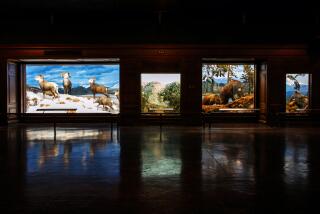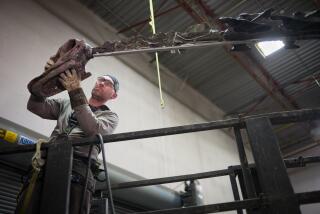‘Eggs-hibit’ Brings Dinosaur Days Back : Museum: San Diego Museum of Natural History exhibit focuses on the creatures that once ruled the Earth.
- Share via
SAN DIEGO — Dinosaur exhibits and natural history museums go together like gin and tonic. Nearly every museum has a stack of bones on display in its main lobby and, in recent years, flashy robotic versions of the beasts designed more to entertain than inform have become as common as the dusty old bones. But the new “Dinosaur Eggs-hibit” at the San Diego Natural History Museum has a twist.
According to museum executive director Dr. Michael Hager, “There is real scientific material here.”
This $250,000 show, which includes six robotic models, centers on the theme of dinosaur birth, a topic often overlooked by museums since eggs are, well, eggs and hardly crowd pleasers in the same league as giant skeletons and robotic recreations.
Dr. Robert Sullivan, a museum paleontologist and the curator of the show, thought differently. Sullivan scoured the country looking for the best examples of dinosaur eggs, and he brought them together with fossil bone specimens that show dinosaur growth.
“Never before has anyone assembled eggs from all the major sites and displayed them with juvenile (bones),” Hager said. “If we just had the robots it would be like empty calories.”
Ask any child and you will discover that dinosaurs are more popular now than they have been in 40 million years. Some 8-year-olds know their T-rex from their triceratops like junior scientists. Still, despite all the dinosaur mania, children and adults are exposed to very little real information about the prehistoric creatures.
The crowds of children and adults at the opening of the “Eggs-hibit” on Saturday may have thought this show was another part of the dino craze. After all, a cute, cuddly baby dinosaur emerging from an egg has been mounted over the museum entrance, and the robots are the headliners.
Instead they found half the hall dedicated to dinosaur eggs and dinosaur fossils in a mixture of high-tech and old-fashioned fossil display techniques.
The exhibit opens with an 18-minute documentary depicting a 1923 journey by scientists from New York’s American Museum of Natural History into Mongolia, China. The expedition, led by Roy Chapman Andrews, the model for Harrison Ford’s Indiana Jones, was the first to confirm what paleontologists had long suspected, the existence of nests of dinosaur eggs. Specimens brought back by the American Museum team are an important part of the current show.
Just outside the small theater, a display uses modern examples to explain just what makes an egg. A second station explores so-called pseudo eggs, objects that are sometimes mistaken for the real thing like the lead fishing weight over which layers of calcium have formed to create a perfect egg shape.
Inside the main hall, Sullivan and his team have used imagery, models, and drawings to demonstrate birth and growth of dinosaur species from various periods in geologic time. They also have real petrified dinosaur eggs.
These include the largest such eggs ever found, from a Hypselosaurus priscus , a late cretaceous dinosaur that roamed France, as well as eggs from Mongolia, and eggs from Montana and other parts of the United States.
Sullivan used cat-scan technology from Children’s Hospital to create 3-D video and flat images of some eggs and juvenile and adult skulls. The rotating 3-D image of a petrified Orodromeus makelai egg appears to clearly show a tiny embryo inside.
Much of what Sullivan has assembled represents the latest information paleontologists have gathered about dinosaur growth and behavior. For example, bones of adult and juvenile dinosaurs found on the north slope of Alaska and bones from the same species in Montana support the theory that dinosaurs actually roamed in herds and migrated with the seasons much like modern reindeer.
Because until the last decade scientists only had records of baby dinosaur bones and adult dinosaur bones, the fossil record was incomplete. Growth patterns displayed in the show were guessed at until scientists uncovered bones from intermediate stages of growth.
And, althoug a cast of one carefully maintained nest of dinosaur eggs seems to prove they made good mothers, rotating the eggs and spacing them equi-distant from each other, some babies weren’t so lucky. A complete fossil skeleton of a small Coelophyfis dinosaur from New Mexico also contains the bones of a baby dinosaur inside the skeleton of the larger dinosaur. According to Sullivan, either that species dinosaur gave birth to babies, not eggs--an unlikely hypothesis, Sullivan said--or it ate its young.
Every aspect of the show is educational. Even the moving, growling robots, which occupy half the exhibit space, have a good deal of information. Small panels have been mounted on faux slabs of rock so visitors can read about each dinosaur in more detail and take short “true-false” quizzes.
According to Hager and Sullivan, the museum’s mission is to spark minds, especially young minds, into learning more about science. What better way, they asked, than with dinosaurs?
If past experience is any indication, some young visitors to the museum may take up the mantle. The famed paleontologist and writer Stephen Jay Gould was much more interested in baseball as a child than he was in science. Until, that is, his father took him to a museum and he spotted a giant dinosaur skeleton. Sullivan had a similar story about his own decision to become a scientist.
He believes people of all ages are intrigued by dinosaurs “because they are extinct, and some were very large. They are no longer here, and that entices the imagination.”
“I think it is a substantiation that monsters really existed,” Hager said. “It is a scientific proof of what exists in our own imagination.”
Besides, he said. “It’s just neat.”
* The Dinosaur Eggs-hibit will run through Nov. 1. Museum admission during the exhibit is $6 for adults, $2 for children ages 6-15 and free for children under 6. Military admission is $4, seniors over 60 are $5. Discount coupons for $2 off adult admission price are available in newspapers and other outlets. Museum hours run from 9:30 a.m. to 5:30 p.m. until Labor Day. Thursday hours are extended until 9 p.m. After Labor Day, the museum is open from 10 a.m. to 4 p.m. For more information call 232-3821.
More to Read
Sign up for Essential California
The most important California stories and recommendations in your inbox every morning.
You may occasionally receive promotional content from the Los Angeles Times.










